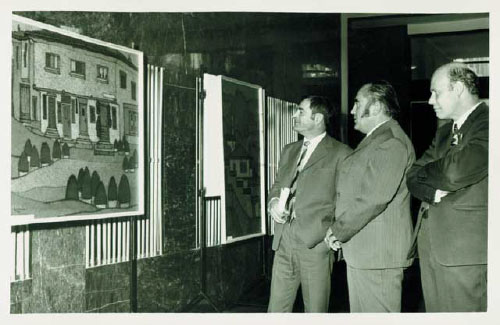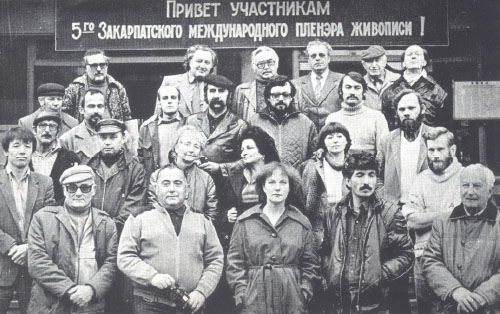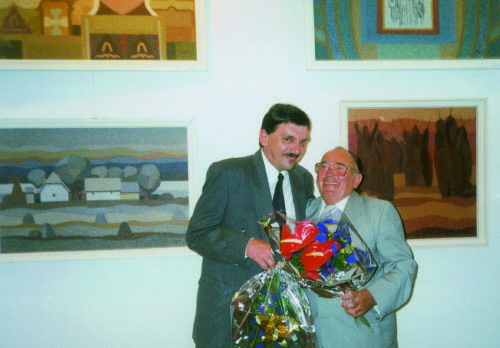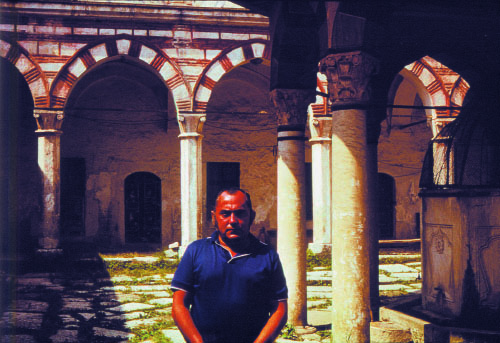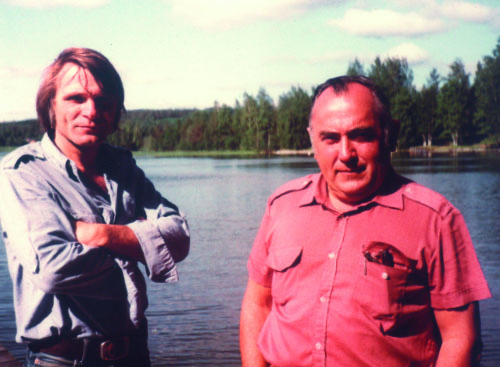| Index | Biography | Works inspired outside Hungary |
Works executed outside Hungary or based on experiences gained abroad
As his heir I continuously research, catalogue and document Imre Égerházi’s works and have organised nearly twenty exhibitions. In addition to exhibitions giving a feel for his total output, I have arranged several centred on specific themes: Alföld, Hortobágy, Debrecen, Transylvania, Shumen, religion, collaborative work and the human form. I have long wanted to stage an exhibition of work painted outside Hungary, but until now I had not found a suitable space. This is why I was delighted by the invitation from the Ministry of Foreign Affairs and Trade: I think that for this theme it would be hard to find a more suitable location. Thus many paintings and graphic works can be exhibited which I have previously been unable to show because of their divergent themes. These are important works, however, which it is very interesting to see together. My father’s first influential experience beyond Hungary’s borders was of the Transylvanian countryside and its people in the mid-1950s. He was instinctively drawn to that region, though at that time he could not have known that his ancestors came to Hajdúhadház from Mezőbánd near Marosvásárhely via Szilágyság. In the early 1970s the art historian Rezsõ Szíj raised the question of whether one of my father’s ancestors was János Egerházi Képíró, the most celebrated Hungarian renaissance painter of coffered wooden ceilings. Then research of his family tree proved that Imre Égerházi was indeed a descendant of the famous painter. But stronger evidence than this emerged when my father entered the Protestant church in Gyulakuta / Fântânele, which had been painted by his ancestor; he almost fainted and had to be sat on a pew. He saw the same flowers, shapes and colours on the ceiling that he used to paint, and which were instinctively his. In the 1960s Hungarian artists in Transylvania were the first to be invited to the Hajdúböszörmény International Artists’ Colony. Later came other Hungarian painters and graphic designers from beyond the borders. These international contacts also formed the basis for his foreign trips. In part due to friendships formed at the colony, and in part thanks to artists’ exchanges arranged with Debrecen’s twin towns, he was able to spend months rich in experience and creative work in places such as: Bulgaria (Shumen, Varna); Germany (Potsdam); Poland (Kazimierz Dolny, Lublin), Finland (Jyväskylä), Yugoslavia (Szabadka/Subotica, Grožnjan); Ukraine (Dubrinics, Kamianka, Munkács/Mukacheve); Lithuania (Klaipeda, Palanga); France (Bessans, St. Michel, Verneuil, Provence); Italy (Tuscany); Turkey (Istanbul); and many others.
Special mention should be made of his regular independent visits to Transylvania, to where he returned every year, and where he would set up his easel in the Gyimes Rajzolás Erdélyben. On these trips he made a great number of sketches in addition to paintings executed there. Returning home he could use these – sometimes years later – to produce paintings evoking the experiences he had felt. Of course, if travel circumstances allowed, he would bring back work painted abroad. In international colonies artists generally leave pictures as gifts to their hosts. As a result, today many of Imre Égerházi’s works can be seen in exhibitions and collections around Europe.
Several free-standing exhibitions have centred on his individual trips abroad. Two exhibitions of works painted in Bulgaria were of great importance. The first was in Debrecen in 1975, on the Day of Bulgarian Poetry. This included paintings inspired by the work of Bulgarian poet Atanas Dalchev – for example, “Sunset”. In the same year all the work from his Bulgarian trip was exhibited in the lobby of the Debrecen University of Agriculture. An exhibition of his pictures from Transylvania was staged in 1995, in Budapest’s Vármegye Gallery. This was also significant because the gallery was founded to present the work of Hungarians artists in Transylvania; an exception was made for Imre Égerházi, however. Firstly, he did much for Hungarian painters in Transylvania, in strengthening their relations with the mother country; secondly, pictures based on Transylvania fascinated the public; and thirdly, Imre Égerházi’s ancestors were Transylvanian artists and nobles.
In the 1970s and ’80s his work from foreign trips decorated the walls of major restaurants in Debrecen. These included the “Shumen” and “Klaipeda” restaurants. He regularly exhibited on three continents. Alongside group exhibitions and gallery appearances there were solo exhibitions, especially in countries where he repeatedly visited artists’ colonies. Among them I would like to point out the Leczna and Lublin exhibitions in 1998, which followed productive work in Poland. Among works located abroad one should highlight the panel painting in Vervins, France. In 1998 the commune’s leaders commissioned a work measuring 4 metres by 6 metres, to mark the 400th anniversary of the Peace of Vervins: a Hungarian painter was entrusted to commemorate an important peace treaty ending the Spanish – French war of religion. It is a tribute to my father’s sense of diplomacy that at the presentation ceremony the Spanish delegation thanked him for not portraying their losing compatriots in a humiliating light. (They had been forced to kneel before the French king Henry IV, but in the painting they are shown standing.)
My father remembers the creation of the painting thus: Budapest, 7 September 2014 Attila Égerházi |
Imre Égerházi and artists’ colonies
It is notable – and of course natural – that most painters cling to their customary studio surroundings, easel and equipment (work table, palette, paints and brushes), fixed location, familiarity with lighting conditions, a handy kettle or coffee pot (for example). At the same time, most painters like to escape from the confines of the studio – especially those who in the 20th century made (and continue to make) a commitment to the 19th-century principle of plein air painting. And this escape can have two dimensions: on the one hand they re-acquaint themselves with familiar, easily accessible and mostly inexhaustible landscapes; and on the other hand they explore those more distant areas which can give fresh impulse and inspiration for the creation of new works. Imre Égerházi belonged to that special category of painters who found inspiration in all three working conditions. He loved his home and his immediate everyday environment, where he worked enthusiastically; he loved the experience of his homeland of the Great Hungarian Plain (Alföld), the visual world of which influenced him throughout his entire life; but he also loved to travel, to see foreign countries and landscapes, which always spurred him to paint endlessly new visions. Over many years he invited Hungarians from beyond the borders and foreign artists to his beloved Alföld, and accepting invitations in return he also travelled a great deal. These pictures of his are remarkable for always strongly conveying the visual quality of the given landscapes and environments, but never abandoning in favour of the effect of a new experience the individual, delicate, warm-toned, finely-textured, intimate visual conception that he had created. It was always clear that new landscape experiences affected him strongly, and it was always clear that personal experiences formed the core of his work, the so called “Égerházi painting”. Dr. Balázs Feledy art historian
|
Learn more about Imre Égerházi on his official website:
www.egerhaziimre.hu
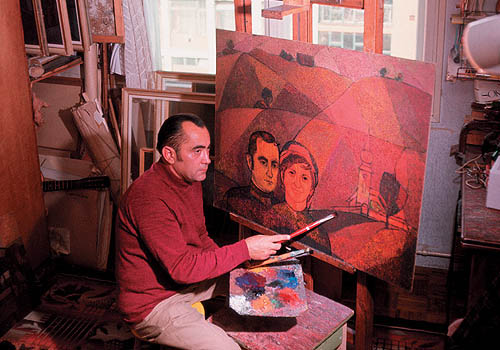
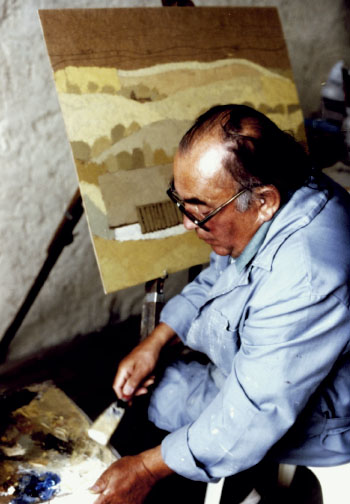 As Imre Égerházi’s son I actively curate my late father’s artistic legacy. As a musician with the band Djabe I worked on an album devoted in its entirety to the interpretation of his paintings, and which we performed as part of an audio-visual tour. This was the album “Sheafs are Dancing”. The title track refers to a painting competed en plein air in Dubrinics / Bercsényifalva, Transcarpathia, in 1985.
As Imre Égerházi’s son I actively curate my late father’s artistic legacy. As a musician with the band Djabe I worked on an album devoted in its entirety to the interpretation of his paintings, and which we performed as part of an audio-visual tour. This was the album “Sheafs are Dancing”. The title track refers to a painting competed en plein air in Dubrinics / Bercsényifalva, Transcarpathia, in 1985.